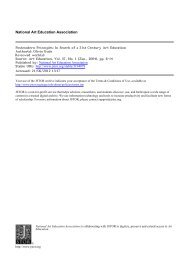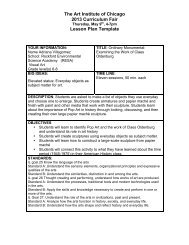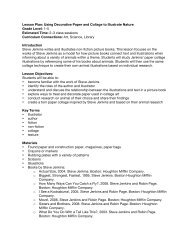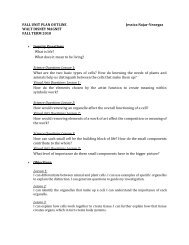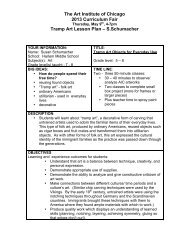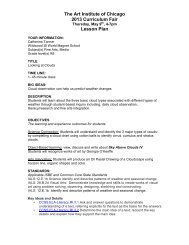Lesson 1 - LearningThroughMuseums
Lesson 1 - LearningThroughMuseums
Lesson 1 - LearningThroughMuseums
You also want an ePaper? Increase the reach of your titles
YUMPU automatically turns print PDFs into web optimized ePapers that Google loves.
English Language Learner Standards<br />
Standard 1 Reading: Arrange information on topics gathered from reading.<br />
Standard 2 Communication: Edit and revise own writing to produce final drafts.<br />
Objectives<br />
• Students will analyze how visual art can communicate ideas.<br />
• Students will infer motives based on an analysis of a painting and its context.<br />
• Students will infer the main idea of a painting.<br />
• Students will use maps to imagine their own potential migration and the reasons behind these desires.<br />
• Students will locate and organize information about the Great Migration.<br />
• Students will explain migration in terms of resources and quality of life.<br />
• Students will create art based on their research and personal choices.<br />
Background Information<br />
The artwork: Train Station, 1935<br />
The artist: Walter Ellison (American, 1899–1977)<br />
The topic: Choices<br />
Relevant Information:<br />
• Walter Ellison’s painting Train Station shows African American and white travelers at a station<br />
bound for different cities.<br />
• Between 1910 and 1970 more than six million African Americans moved from the South to cities<br />
in the North to find better jobs and opportunities. This large movement of people is called the Great<br />
Migration.<br />
• Many came to live and work in Chicago, including Walter Ellison, who came to Chicago from<br />
Georgia in the 1920s. In fact, the station in the painting may be based on the station in Macon, from<br />
which Ellison likely departed for the North.<br />
• Train Station is divided into three sections by two large columns located in the foreground, or area<br />
closest to the viewer. These columns prevent African American and white passengers from<br />
mingling. Ellison used them to visually represent one of the themes of the painting, which is<br />
the impact of the segregation.<br />
• In the middle ground of the painting to the right, we see an African American woman enter an area<br />
labeled “Colored.” In the South, under segregation, blacks and whites were not able to use the same<br />
public facilities like water fountains, bathrooms, and restaurants and did not have equal access to<br />
educational and professional opportunities. Discriminatory laws called Jim Crow laws severely<br />
restricted opportunities for African Americans.<br />
• On the left, white passengers board trains traveling to vacation destinations in the South such as<br />
Miami and West Palm Beach. On the right, African American passengers wait for trains going north<br />
to cities like Chicago, New York, and Detroit.<br />
• The center section shows African American porters, or railroad employees who carry travelers’<br />
bags, assisting white passengers and directing an African American passenger to the trains heading<br />
north.<br />
Art Institute of Chicago • 81



